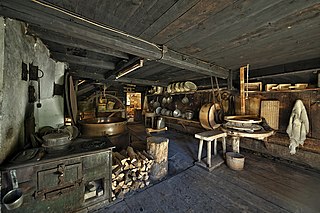
A dairy is a place where milk is stored and where butter, cheese and other dairy products are made, or a place where those products are sold. It may be a room, a building or a larger establishment. In the United States, the word may also describe a dairy farm or the part of a mixed farm dedicated to milk for human consumption, whether from cows, buffaloes, goats, yaks, sheep, horses or camels.
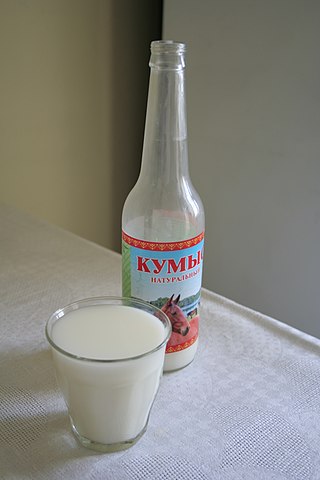
Kumis is a fermented dairy product traditionally made from mare milk or donkey milk. The drink remains important to the peoples of the Central Asian steppes, of Turkic and Mongol origin: Kazakhs, Bashkirs, Kalmyks, Kyrgyz, Mongols, and Yakuts. Kumis was historically consumed by the Khitans, Jurchens, Hungarians, and Han Chinese of North China as well.
Agnihotra refers to the yajna of offering ghee into the sacred fire as per strict rites, and may include twice-daily heated milk offering made by those in the Śrauta tradition. The ritual has been described by P.E. Dumont as a "fertility charm", and as a "solar charm" which symbolically preserved and created the sun at nightfall and sunrise.
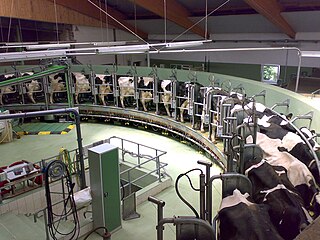
Dairy farming is a class of agriculture for the long-term production of milk, which is processed for the eventual sale of a dairy product. Dairy farming has a history that goes back to the early Neolithic era, around the seventh millennium BC, in many regions of Europe and Africa. Before the 20th century, milking was done by hand on small farms. Beginning in the early 20th century, milking was done in large scale dairy farms with innovations including rotary parlors, the milking pipeline, and automatic milking systems that were commercially developed in the early 1990s.
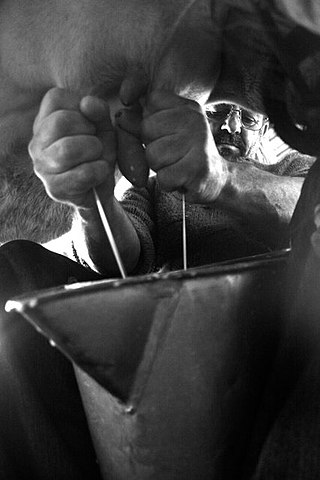
Milking is the act of removing milk from the mammary glands of cattle, water buffalo, humans, goats, sheep, and, more rarely, camels, horses, and donkeys. Milking may be done by hand or by machine, and requires the animal to be currently or recently pregnant. The milker may refer either to the animal that produces the milk or the person who milks said animal.
The Ctistae or Ktistai were a group/class among the Mysians.
Simplexvirus bovinealpha2, also known as Bovine alphaherpesvirus 2 (BoHV2) is a virus of the family Herpesviridae. It causes two diseases in cattle, bovine mammillitis and pseudo-lumpy skin disease.
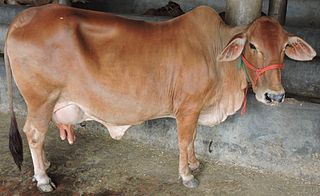
Sahiwal cattle is a breed of Indian zebu cow, named after the Sahiwal district of modern-day Pakistan.. The cattle is mainly found in Punjab province of Pakistan, and Indian states of Punjab, Haryana, & Rajasthan.
A milking pipeline or milk pipeline is a component of a dairy farm animal-milking operation which is used to transfer milk from the animals to a cooling and storage bulk tank.

The Beetal goat is a breed from the Punjab region of India and Pakistan is used for milk and meat production. It is similar to the Jamnapari goat and the Malabari goat.
Milker's nodules are a cutaneous condition that is most commonly transmitted from the udders of infected cows. Milker's nodule is caused by Paravaccinia virus. The disease in humans is nearly identical to Orf.

Dairy farming in New Zealand began during the early days of colonisation by Europeans. The New Zealand dairy industry is based almost exclusively on cattle, with a population of 4.92 million milking cows in the 2019-20 season. The income from dairy farming is now a major part of the New Zealand economy, becoming an NZ$13.4 billion industry by 2017.

Signal's Lily Flagg 31035 (1884–?), also spelled Flag, was a Jersey cow, the top butter producer in the world in 1892, owned by W. E. Matthews and General Samuel H. Moore of Huntsville, Alabama. During her record-breaking year, she weighed 950 pounds (430 kg) and produced 1,047 pounds 3⁄4 ounce (474.93 kg) of butter. Her parents were sire Georgian 6073 and dam Little Nan 15895.
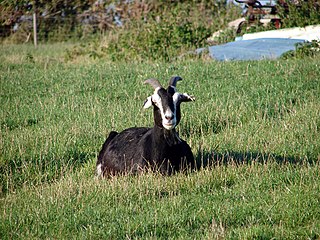
The British Alpine goat is a breed of domestic goat developed in the early 1900s. A standard British Alpine goat is black all over with white 'Swiss' markings. Another well-known breed that has these markings is the Toggenburg goat, and the breed was developed from the Toggenburg, native British goats, and Nubian genetics. The British Alpine is a high producer of quality goats' milk, and the breed can be found in many goat dairies as an acceptable milker. These goats are capable of extended lactations, sometimes even lasting close to two years.

The swill milk scandal was a major adulterated food scandal in the state of New York in the 1850s. The New York Times reported an estimate that in one year 8,000 infants died from swill milk.

Wild cow milking is a rodeo event seen at mainstream and ranch rodeos. A team-based competition, the goal is to catch and milk a "wild" cow in as short a time as possible. The competition dates back at least to the early 20th century, with competitions at the Cheyenne Frontier Days rodeo photographed as far back as 1924.
Pseudocowpox is a disease caused by the Paravaccinia virus or Pseudocowpox virus, a virus of the family Poxviridae and the genus Parapoxvirus. Humans can contract the virus from contact with livestock infected with Bovine papular stomatitis and the disease is common among ranchers, milkers, and veterinarians. Infection in humans will present with fever, fatigue, and lesion on the skin.
Anna Baldwin (1832-1888) was an American dairy farmer and inventor. She operated a dairy farm in Newark, New Jersey who was most famous for her Hygienic Glove Milker, patented on February 18, 1879.
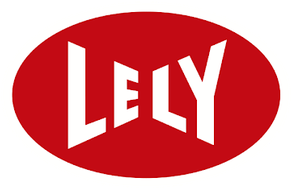
Lely Industries N.V. is a Dutch agricultural machine and robots manufacturer which is based in Maassluis, the Netherlands. It is considered as one of the leading dairy robot manufacturers.











